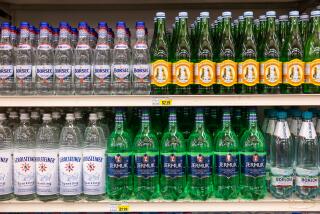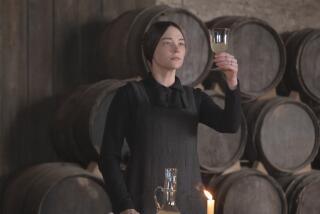California Dreamers
The California wine industry is blushing, and not with embarrassment. Now flooding the market are delicately colored wines that promise new customers and profits to a business badly in need of both.
Popularly called “blush” wines, they range in color from off white through an attractive range of pale peaches and pinks. Their technical name is blanc de noir, which means “white wine made from red wine grapes.” And although rosy colored, they are not the same as rose wines.
Blush wines acquire their slight color during the initial crushing and pressing that separate skins and stems from the juice. They are not fermented on the skins. Rose wines, on the other hand, are allowed to ferment a few hours with the skins to deepen their color. This, however, is a generalization that may not apply to all wines. Within the class, there are variations in wine-making technique. Some wine makers use a single grape. Some blend several red wine grapes. Some blend in white wines such as Chenin Blanc or Chardonnay.
Often slightly sweet and sometimes spritzy, the new pale wines have a crisp edge that makes them refreshing and pleasant to drink, with or without food. They also are inexpensive, ranging from $1.99 to a high of about $6.
“It’s a major, major trend,” said Larry Holzer, wine buyer/merchandiser for the 41 stores in the Liquor Barn’s Southern California region. Earlier this year, the chain, a division of Safeway Stores Inc., increased the space allotted to blush wines threefold, Holzer said.
“They are definitely Yuppie wines. They just seem to go with the life style. Women love them,” Holzer added. Although some take the wines as lightly as their color, Holzer sees them as “a serious varietal category.”
Red wine grapes have been used in California champagnes for decades. The modern blush wines appeared more recently. In 1972, Sutter Home Winery in St. Helena, acknowledged as a forerunner in the field, introduced its White Zinfandel. According to Walter Hampe, winery spokesman, only 500 gallons were made of what was then a dry wine. Over the years, the wine became lighter and sweeter, acquiring its present character around 1980.
Whereas some wines show off pretty peach tones, Sutter Home’s White Zinfandel is one of the palest. “We figure, White Zinfandel, we really ought to make it as white as possible,” Hampe said. To achieve this pale look, the grapes are harvested before the skins have acquired full color, and the juice is taken off the skins as quickly as possible, he said.
Sutter Home’s success has inspired many others. Hampe said that 117 wineries were making White Zinfandels as of September, and the demand has driven up the price of the Zinfandel grape.
Not only Zinfandel, but Cabernet Sauvignon, Pinot Noir, Gamay, Barbera and Merlot are turning into pale versions of themselves. Sutter Home’s initial White Zinfandel production of 200 cases has grown to 1.2 million cases this year, Hampe said. Other wineries have joined in to make a considerable amount of pale wine available. Industry sources estimate that the market for blush wines is now 2.5 million cases a year, or about 6 million gallons. They predict this figure will rise to 9 million cases, or even more, in 1986.
John De Luca, president and general manager of the Wine Institute, a trade organization based in San Francisco, sees blush wines as ideal for initiating new wine drinkers. “In terms of an industry that wants to appeal to more and more consumers and infrequent consumers, this is a positive development,” he said. “They’re attractive to the eye, and they’re attractive to the palate. We are trying to demystify wine, and this (the blush wine trend) is consonant with that approach.”
De Luca lists several reasons for the success of the wines. The initial stimulus for making them was the abundance of red wine grapes at a time when consumers wanted white wines. Meanwhile, improvements in wine-making technology gave wine makers greater artistic freedom. In addition, the wines require little aging and are out on the market quickly. “For our wineries, it helps in terms of cash flow,” he said.
Consumer acceptance of the wines has been great. The Liquor Barns “are getting bombarded with requests for blush wines,” Holzer reported.
“I think they’re really meeting the kind of life style changes we see occurring,” De Luca added. “They are eminently drinkable. They go extremely well with food. They’re very fruity, very well balanced.” They are also “chillable,” he added, noting that Americans like their beverages cold.
First Cabernet Blush
Although blush may seem a logical name for these lightly colored wines, the term is legally the property of only one winery, Mill Creek Vineyards of Healdsburg in Sonoma County. Mill Creek produced its first Cabernet Blush with the vintage of 1976.
What to name the new wine became an issue resolved in a discussion with syndicated wine writer Jerry Mead. Mead recalls: “It was the first visit I had paid to Mill Creek. The last thing they brought out was an unlabeled sample. It did not have nearly the color of a rose, but it had considerably more color than the blanc de noirs of the time. It was delicious--not as sweet as most roses were 10 years ago, very fruity, not as sharply acidic as some of the blanc de noirs of the time.”
Observing the color of the wine, Mead told its producers, “You sure did pick up a helluva blush.” Mead’s claim to have originated the name is substantiated by venerable wine authority Leon D. Adams. In his book, “The Wines of America,” published by McGraw-Hill, Adams writes in a passage about Mill Creek, “Wine writer Jerry Mead happened by, tasted the wine, and at his suggestion they named it Cabernet Blush.”
That was not the end of the story. Mill Creek went on to apply for a trademark for the term blush in 1978. The trademark was granted on both state and federal levels in 1981, said Bill Kreck, winery general manager. In 1980, the winery mailed notification of the trademark to Wine Institute members, Kreck said. From 1978 to 1984, a “very small” number of wineries employed the term blush without knowing of the trademark and have since discontinued its use, he reported.
This year, the Seagram Wine Co. challenged the trademark. Seagram felt that blush had become a generic term and wanted to apply it to a pale-colored generic blend produced by Taylor California Cellars. Mill Creek objected. The result was an out-of-court settlement that allows Taylor to use the name under a licensing arrangement. Kreck says Mill Creek has licensed a number of other wineries to use the name “blush.” According to Kreck, the fee is decided on a per-case basis and varies according to the number of cases involved.
“It would have been more expensive for Seagram to fight it in court rather than settle it out of court with Mill Creek,” said Marcy Whitman, Seagram’s senior product manager for Taylor California Cellars. According to Whitman, the settlement was a one-time-only payment of less than $3,000. The settlement, she said, was “an admission on their (Mill Creek’s) part that they wouldn’t have any ground to stand on if they had gone to court.”
Kreck said the winery has not profited from the arrangement. “I suppose we are getting close to breaking even,” he said, with attorneys’ fees in mind. Mill Creek’s trademark does not apply outside the United States. But a French wine produced for marketing in this country has been licensed to use the word blush on the label.
Produced in France by Yvon Mau Wines Inc., “French Blush” is a blend of Cabernet Sauvignon and Merlot. Pink and fruity with a touch of effervescence, it is now being introduced to the East Coast and Midwest and will reach California later, according to Ron Olsavsky, administrator of Yvon Mau Wines in New York City, the distributor.
Closer to home, wineries anxious to get on the blush bandwagon are seeking wines to bottle under their labels. “We have wineries calling us just to see if we have excess to sell in bulk,” said Santo Riboli, vice president of San Antonio Winery in Los Angeles. San Antonio now makes a California Bouquet Barbera Blanc, which will be renamed White Barbera with the 1985 vintage. The winery also makes a White Zinfandel and plans to introduce a Cabernet Blanc before Christmas.
Riboli and other wine authorities see the blush wines separating into two categories, those made with the same refined techniques applied to fine table wines and less ambitious wines. “There are some really choice White Zinfandels out and some good White Zinfandels and not much in between,” Riboli observed.
So great is the demand for blush wines that Mirassou Vineyards saw its newly introduced White Zinfandel rise in one year to become its top-selling wine. According to Larry Rugani, national sales manager, 45,000 cases of the 1984 White Zinfandel have been sold since the beginning of the year. The winery is aiming at 70,000 cases in 1986. “White Zinfandel is the wine of the people right now,” Rugani commented.
The future for blush wines includes sparkling and low-alcohol variations. In 1986, Mirassou will release Pastel, a low-alcohol blend of its White Zinfandel with unfermented White Zinfandel juice. Rugani sees Pastel as a new category of product, not a blush wine. Nevertheless, it will have the same “beautifully pink” color as the White Zinfandel, he said. The alcohol content will be 6% to 7%.
Sutter Home Winery has just released Sparkler, a low-alcohol (9% by volume) sparkling wine produced from the same grapes as its White Zinfandel. Sparkler is as sweet as the still White Zinfandel but a brighter pink. This and other bubbly blush wines sound like pretty rivals to champagne as wedding wines.
Speaking of weddings, no blush wine could be more romantic than R. & J. Cook’s Merlot Blanc. The label says this deeply colored, sweet wine has been estate bottled “expressly for Joanne.” Joanne is the “J” referred to in the name of the small winery, which is located in Clarksburg, about 20 miles south of Sacramento. “R” is her husband, Roger. “Roger and I have been married seven years this November,” said Joanne Cook. “That’s how it (the sentimental dedication) came about. It just fit in with the way we feel about each other.”
More to Read
Eat your way across L.A.
Get our weekly Tasting Notes newsletter for reviews, news and more.
You may occasionally receive promotional content from the Los Angeles Times.










